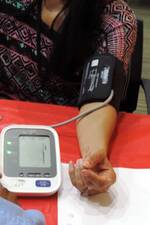Author Interviews, HIV / 29.03.2022
Study Sheds Light On How Immune System Allows HIV Infection to Be Chronic
MedicalResearch.com Interview with:
Shokrollah Elahi PhD
Associate Professor at University of Alberta
MedicalResearch.com: What is the background for this study?
Response: CD8+T cells (killer T cells) play an important role against virally infected and cancer cells, however, their functional properties get compromised during the course of HIV infection and cancer. CD73, is one of molecules that influences killer T cell functions but its role in the context of viral infections has not been well defined.
In this study, we analyzed the presence of this protein (CD73) on killer T cells in a cohort of 102 HIV-infected individuals. We found that the proportion of killer T cells expressing this protein was substantially lower among different killer T cell subsets obtained from the blood of HIV-infected individuals compared to individuals who were not infected with HIV. Notably, CD73 was decreased at the intracellular protein and gene levels. This suggests that the CD73 gene gets suppressed by a specific mechanism in HIV-infected individuals.
Furthermore, we decided to better understand the difference between killer T cells having CD73 versus those who do not. We found that CD73 was essential for the migratory capacity of killer T cells. It means killer T cells without this protein have impaired ability to move into the tissues. This implies that lack of CD73 prevents killer T cells from homing into the tissue where HIV reservoirs are hidden.
(more…)














 Arman A. Shahriar
Medical Student, University of Minnesota Medical School Research
Consultant, HealthPartners Institute
Minneapolis, Minnesota
Arman A. Shahriar
Medical Student, University of Minnesota Medical School Research
Consultant, HealthPartners Institute
Minneapolis, Minnesota





 Response: Cigarette smoking is one of the well-established causes of periodontitis, but the effect of using electronic cigarettes (e-cig), especially its long-term impact on periodontal health, is not yet clearly understood. Considering the increased popularity of e-cig use, especially among teenagers and young adults, and the known effect of high nicotine concentration in e-cigarette products, we conducted this clinical research to see if there were differences in periodontal health between e-cig users, traditional smokers, and nonsmokers. The study consisted of two visits, 6 months apart, where measures of oral and periodontal health were obtained.
Our data showed significantly greater clinical attachment loss in the e-cigarette users and cigarette smokers than in the non-smokers at both study visits. In only e-cigarette users, we observed an over 0.2 mm average increase in the clinical attachment loss after 6 months.
Response: Cigarette smoking is one of the well-established causes of periodontitis, but the effect of using electronic cigarettes (e-cig), especially its long-term impact on periodontal health, is not yet clearly understood. Considering the increased popularity of e-cig use, especially among teenagers and young adults, and the known effect of high nicotine concentration in e-cigarette products, we conducted this clinical research to see if there were differences in periodontal health between e-cig users, traditional smokers, and nonsmokers. The study consisted of two visits, 6 months apart, where measures of oral and periodontal health were obtained.
Our data showed significantly greater clinical attachment loss in the e-cigarette users and cigarette smokers than in the non-smokers at both study visits. In only e-cigarette users, we observed an over 0.2 mm average increase in the clinical attachment loss after 6 months. 










 Johonniuss Chemweno
CEO of VIPStarNetwork
MedicalResearch.com: What is the mission of VIP StarNetwork?
Response: VIP StarNetwork’s mission is to expand access to healthcare services and information, especially in underserved and underprivileged communities. Our comprehensive group of health experts, leading physicians, and healthcare executives are working to create a meaningful and safe environment to ensure that patients have equitable and streamlined access to vaccines and other forms of care.
Johonniuss Chemweno
CEO of VIPStarNetwork
MedicalResearch.com: What is the mission of VIP StarNetwork?
Response: VIP StarNetwork’s mission is to expand access to healthcare services and information, especially in underserved and underprivileged communities. Our comprehensive group of health experts, leading physicians, and healthcare executives are working to create a meaningful and safe environment to ensure that patients have equitable and streamlined access to vaccines and other forms of care.